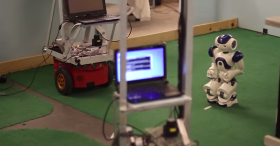Robotic technology aims to help elderly
Published 10:49 am Monday, March 2, 2015
Reminding Grandma to take her pills, monitoring her daily activities and taking care of her needs around the clock without holidays off can be a lot for one person to handle. But would she allow a caregiver with an electronic brain to take on that responsibility?
Two Oklahoma State University researchers are hoping to convince her of new technology.
Weihua Sheng and Guoliang Fan were awarded a $725,000 grant by the National Science Foundation in December to help develop robots that will act as companion caregivers.
Sensors on it charge and throughout his or her environment would allow the robots to learn their health needs and daily activities. A built-in microphone and camera would give the robots the ability to map the living space in its memory, hear what’s happening around it and react to emergencies.
Sheng, 43, began working on robots for manufacturing purposes in 2000 while he was studying for his PhD at Michigan State University.
“When I graduated and I entered the university, I started to think about how can we use robots to help people in homes, not just manufacturing settings,” Sheng said. “We explored this idea so we developed what we call home service robots. With this kind of home service robot we can really help people at home.”
OSU has invested $400,000 into the project so far, but data still needs to be studied regarding privacy, software and ultimately testing the robot in an assisted living environment.
The current robot prototype is bare bones. It does not have arms, nor a human shape or size. The robot’s intelligence also still needs to improve to fully understand a human’s gestures and interactions.
“If the robot is equipped with this kind of capability, I believe the elderly would be more likely to accept this kind of robot in their homes,” Sheng said. “This grant definitely will give us a boost, a big help to deliver the more realistic robot that can really be deployed in the home environment.”
Sheng said he hopes the price will be more affordable by the time the product hits the market — which he calls in the range of $10,000. However, the price also depends on the capabilities of the robot. They may have different features depending on what type of environment they will be used in, a personal home or nursing home.
“I think the robot should be able to work in both the environments,” Sheng said.
Of the many challenges Sheng and his research team have encountered while developing the caregiving robot, the main concern is having people learn to trust new technology. Kelly Johnson, director of nursing at Golden Oaks Village, said she is skeptical if the robot could properly perform the medical duties of a caregiver.
“It’s a computer,” Johnson said. “Errors can happen very easily with it. Our computers have issues, and if you have a person that you’re depending on for life or death and it has a malfunction, that wouldn’t be good.”
However, the duties of a caregiver go far beyond medical responsibilities.
“The duties or the tasks to do is minimum compared to the relationship and the emotional connection, spiritual connection, all of that,” Johnson said. “You might have somebody there for emergencies, but what about the day to day? And to me your medical situation is very important, but so is your social aspect. And if they don’t have social and spiritual I think they would just exist. I don’t think that they would have near of a quality of life.”
For instance, what about Golden Oaks resident Laura Schlobohm, 96, who enjoys playfully bossing around her caregivers? When Schlobohm moved to Stillwater from Kansas to be near her daughter she quickly became accustomed to life at Golden Oaks and made friendships with the staff and other residents.
“I’m used to arguing, so I want someone that will argue back,” Schlobohm said. “I think I would miss the repartee, the companionship that you get with humans as opposed to a robot.”
However, Schlobohm said she isn’t concerned about privacy issues.
“That robot isn’t going to tell anymore than whatever the human releases from it,” Schlobohm said. “Let’s face it, that robot isn’t going to work on its own. He has a handler some place who is feeding all that.”
She is not fearful of the technology, which many might expect.
“I would accept it because that’s all I’m going to have,” Schlobohm said. “I’m never one to live in the present. I’m ‘let’s get on with it, there’s other things to do and see’.”
It could be close to 10 years before this robot is ready to be a viable product. Graduate student Yehenew Mengistu, who is assisting in the research of these robots, said even though the product looks simple there are many programs that need to be sorted out.
“It might take you a long (time) to reach your results, your goals, but when you see it functioning it’s interesting,” Mengistu said.
Although researchers call their robots a companion, some see them as more automated than personable. But even this new take on technology wouldn’t be able to squash Schlobohm’s feisty, vibrant personality. “They’re never going to replace the bridge table, and that’s where I spend a lot of my time,” Schlobohm said.
This article first appeared in the Stillwater (Ok.) News Press





